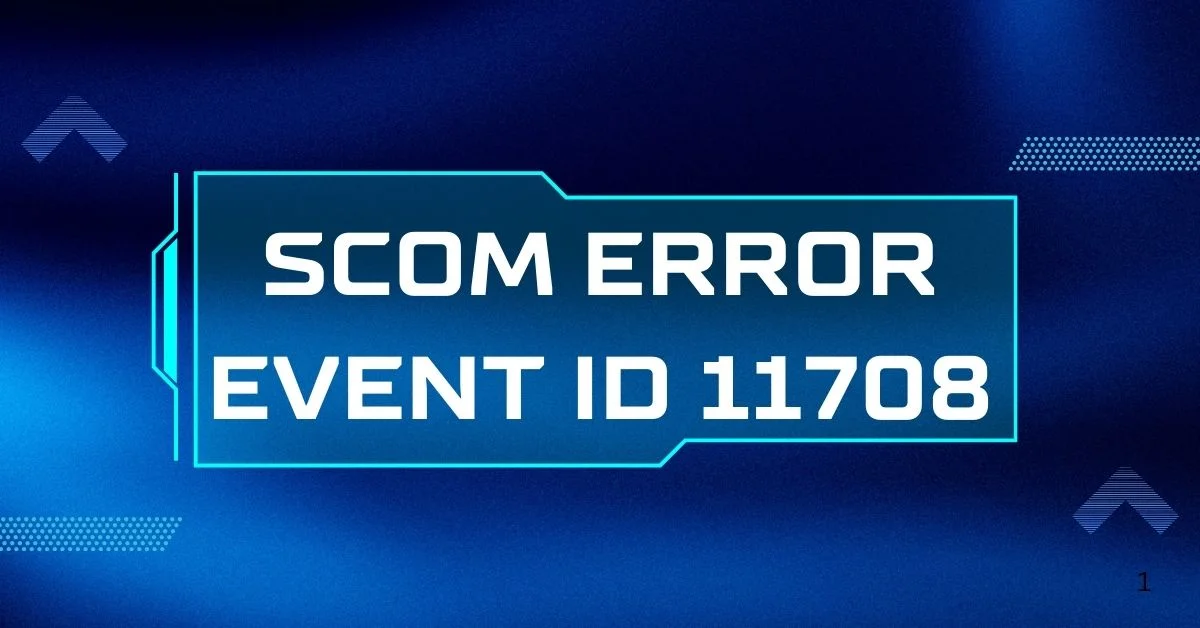System Center Operations Manager (SCOM) is a powerful monitoring tool used to oversee the health and performance of IT systems. While it facilitates smooth system operations, users may occasionally encounter errors, such as Event ID 11708, which is associated with failed installations. If you’ve come across this issue and are looking for clarity, actionable solutions, and preventative measures, don’t worry. This guide is here to help.
This article walks you through the specifics of SCOM Error Event ID 11708 what it is, why it happens, its impact, and, most importantly, how to resolve it effectively. Whether you’re a system admin or an IT enthusiast, this guide is easy to follow yet thoroughly detailed.
What Is Event ID 11708?
Event ID 11708 is logged by the Windows Installer (MsiInstaller) when a software installation or removal operation fails. It’s not specific to SCOM but can appear in SCOM-related scenarios, such as:
- Installing or upgrading the SCOM agent.
- Deploying SCOM management packs.
- Performing maintenance on SCOM infrastructure.
The error message in the Event Viewer often looks like this:
“Product: [Application Name]. Installation operation failed.”
For SCOM administrators, seeing this error can be frustrating, especially when trying to maintain a smooth monitoring environment. Let’s explore why this happens.
Key Causes of Event ID 11708
1. Insufficient Permissions
Many Windows Installer errors stem from inadequate permissions. If the installation process lacks administrative rights, it may fail and trigger this error.
2. Corrupted Installation Files
If the installation files for the SCOM agent or other components are incomplete or corrupted, the installer cannot proceed.
3. Dependency Issues
SCOM installations often require specific software dependencies, such as:
- .NET Framework
- SQL Server components
- Windows Management Framework
Missing or incompatible dependencies can cause the installer to fail.
4. Group Policy Restrictions
In environments with strict Group Policy settings, software installations may be blocked or restricted, leading to Event ID 11708.
5. Registry Conflicts
Leftover registry entries from a previous installation or an older version of SCOM can interfere with the current installation process.
6. Antivirus or Firewall Interference
Security software can mistakenly flag installation processes as suspicious, blocking or disrupting them.
7. Corrupt Windows Installer Service
The Windows Installer service (msiexec.exe) is responsible for handling MSI-based installations. If it’s corrupted or not functioning correctly, installations will fail.
How to Troubleshoot Event ID 11708
Here are step-by-step methods to identify and resolve the root cause of this error.
Step 1: Review Event Viewer Logs
Start by checking the Event Viewer for details about the error:
- Open Event Viewer (Windows + R, then type eventvwr.msc).
- Navigate to Windows Logs > Application.
- Look for Event ID 11708 and examine the detailed description.
Tip: The error message often includes the name of the failing application, which can help narrow down the issue.
Step 2: Verify User Permissions
Ensure the installation process has the necessary administrative privileges:
- Run the installer as an administrator by right-clicking the installer file and selecting Run as Administrator.
- Confirm that the account performing the installation has local admin rights.
Step 3: Repair or Reinstall Dependencies
Check for missing or corrupted dependencies required by SCOM:
Common SCOM Prerequisites:
- .NET Framework: Ensure the required version is installed and updated.
- Windows Management Framework: Confirm compatibility with your SCOM version.
- SQL Server Native Client: Verify it is correctly installed if used.
How to Fix:
- Reinstall or repair missing dependencies using their official installers.
- Run Windows Update to ensure your system has the latest components.
Step 4: Check for Group Policy Restrictions
Group Policy settings may block MSI-based installations. To verify:
- Open Group Policy Editor (gpedit.msc).
- Navigate to:
- Computer Configuration > Administrative Templates > Windows Components > Windows Installer.
- Ensure settings like “Disable Windows Installer” are not enabled.
Step 5: Clean Up Previous Installations
Leftover files or registry entries from previous installations can cause conflicts. To resolve this:
- Use the Microsoft Program Install and Uninstall Troubleshooter to remove remnants of failed installations.
- Manually clean up:
- Delete related files in C:\Program Files\ or C:\Program Files (x86)\.
- Search for and delete relevant registry keys using Regedit (ensure you back up the registry first).
Step 6: Use Verbose Logging for the Installer
Verbose logging provides detailed insights into what went wrong during the installation process.
How to Enable Logging:
- Open a command prompt.
- Run the installer with verbose logging:
msiexec /i “<Path_to_Installer>.msi” /L*v “<Path_to_Log_File>.log”
- Review the log file for specific error messages or codes.
Step 7: Repair the Windows Installer Service
If the Windows Installer service itself is the culprit, you may need to repair or re-register it:
How to Re-register:
- Open a command prompt with administrative privileges.
- Run these commands:
- msiexec /unregister
msiexec /register
How to Restart the Service:
- Press Windows + R, type services.msc, and hit Enter.
- Locate Windows Installer, right-click, and choose Restart.
Step 8: Temporarily Disable Security Software
Antivirus programs or firewalls may block or interfere with the installer. Temporarily disable them and reattempt the installation. If successful, configure exceptions for the installer in your security software.
Step 9: Verify Disk Space and System Health
Ensure the system has sufficient disk space and no corruption:
- Free Disk Space: Clear unnecessary files if space is low.
- System File Checker (SFC): Run sfc /scannow to repair corrupted system files.
Step 10: Seek Official Support
If none of the above methods resolve the issue, consider the following:
- Contacting Microsoft Support for assistance.
- Consulting SCOM community forums for guidance from experienced administrators.
Preventing Event ID 11708 in the Future
To avoid encountering this error again, follow these best practices:
Maintain a Clean Environment
- Regularly remove outdated or unused software.
- Keep the system’s registry clean with tools like CCleaner (use cautiously).
Update Dependencies Proactively
- Regularly update .NET Framework, SQL Server, and other essential components.
- Stay informed about SCOM’s compatibility requirements for each version.
Test Installations in a Lab Environment
- Before deploying changes to a production environment, test installations in a controlled lab setup.
Document Configuration Changes
- Maintain detailed records of system configurations and installed software to simplify troubleshooting.
Implement Robust Monitoring
- Use SCOM’s monitoring capabilities to track system health and identify potential issues proactively.
Conclusion
Event ID 11708 can be frustrating, but with a methodical approach, you can identify and resolve the underlying issues quickly. Whether it’s related to permissions, dependencies, or system health, following the steps outlined in this guide will help you troubleshoot effectively.
By maintaining a clean, updated environment and documenting your configurations, you’ll also reduce the likelihood of encountering this error in the future. Remember, proactive management is the key to a smooth SCOM experience.



